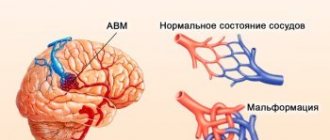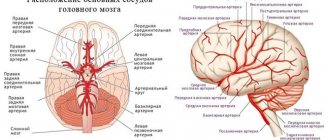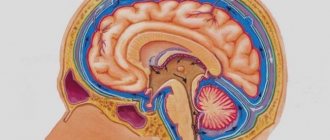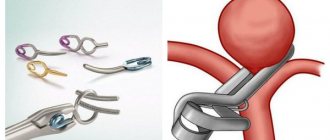In medicine, the term sinus durae matris - sinuses of the dura mater, implies vascular collectors located between the plates of the dura mater. These are peculiar triangular ducts with endothelium on the surface, formed in the splits of the hard layer of the brain. They are supplied with blood from the internal and superficial vessels of the brain, and participate in the reabsorption of cerebrospinal fluid from the cavity between the arachnoid and non-solid medulla.
Functions of sines
There are specific tasks for the venous sinuses.
They perform the function of uninterrupted supply of blood and oxygen to the vessels of the brain. It is through them that blood directly flows from the head organ to several double veins located in the neck, which carry blood away from the upper part of the body. The sinuses of the dura mater perform the functions of blood vessels, and in addition take part in the metabolism of cerebrospinal fluid. The structure is very different from the cerebral vessels.
Successful drainage of blood from the cerebral vessels often saves from the occurrence of fatal pathologies. In cases where difficulties arise in the field of vascular blood circulation, it becomes possible to quickly eliminate it, thanks to the recanalization of blood vessels and the formation of collaterals.
Pathology of intracranial sinuses
Diseases of these vascular formations are most often caused by their occlusion, which can be caused by thrombosis, thrombophlebitis, or tumor compression of intracranial vessels.
Inflammatory diseases of brain structures can occur when infectious agents enter the venous blood stream (purulent emboli). The infection can be brought to the membranes of the brain from the superficial venous vessels of the skull. In this case, the development of a clinical picture of acute meningitis and encephalitis is possible. In young children, a picture of neurotoxicosis develops.
Sometimes neurosurgeons may suspect a fracture of the base of the skull when they see a picture of pulsating exophthalmos. When injured, the internal carotid artery associated with the cavernous canal is damaged. A stream of arterial blood, entering the ophthalmic veins associated with this sinus, causes pulsation, severe redness and protrusion of the eyeball. This pathology is otherwise called carotid-cavernous anastomosis, and this is one of the rarest conditions when listening to the head with a phonendoscope allows you to hear the sounds of blood in the area of the anastomosis.
When the walls of the sinus are damaged, a number of neurological symptoms appear due to damage to nearby branches and nuclei of the cranial nerves. With pathology of the cavernous sinus, oculomotor disorders and the development of trigeminal neuralgia may occur.
If the patient suffers from frequent attacks of headaches or intracranial hypertension, the development of reverse (retrograde) blood flow is possible - from the brain cavity to the superficial veins of the skull. Therefore, in children with intracranial hypertension, the pattern of veins on the scalp is clearly visible. Due to the flow of blood, the pressure inside the skull decreases. This is a compensatory mechanism for reducing intracranial pressure.
Important How to choose sleeping pills: without prescriptions for sound sleep, potent, for children, pregnant women
The cerebral sinuses are an important component of the cerebral venous network. Knowing their functions, structural features and localization, experts can assume the development of pathology in a certain area of the brain. To clarify the diagnosis, magnetic resonance imaging with intravascular injection of a contrast agent is necessary.
Rate this article:
- 4.21
Total votes: 96
The structure of the sinuses of the solid MO
The development of TMO collectors occurs due to their division into two sheets, which are similar to channels. These ducts are designed to distribute the venous flow of blood from the main human organ, which is subsequently sent to several double vessels that are located in the neck and transfer blood from the brain.
The dura mater plates that make up the sinus look like tightly stretched ropes that do not lose tension. This structure allows blood to flow freely from the head and neck, without in any way affecting the state of intracranial pressure.
The following types of dura mater reservoirs have been established in humans:
- Superior or inferior sagittal. The first is located longitudinally along the upper border of the falx bone and ends on the occipital fragment, and the next is longitudinally along the border of the falx below and flows into the straight sinus;
- Straight. It is located longitudinally of the fragment, where the falciform process passes into the cerebellar tentorium;
- Transverse (double). Formed on the transverse growth of the skull, located longitudinally along the posterior border of the cerebellar groove;
- Occipital. It is located in the cavity of the cerebellar arch, and then extends to the occipital junction;
- Sigmoid. Located in the division in the ventral fragment of the head bone tissue;
- Cavernous (double). It is located on the sides of the formation of a wedge-shaped bone in the body (sella turcica);
- Sphenoparietal sinus (double). Refers to a small wedge-shaped border of bone and ends in a cavernous reservoir.
Stony (double). Located close to both borders of the pyramidal bone of the temples.
The collectors of the medulla begin to collect anastomoses with venous vessels on the surface of the brain, through venous branches that connect the vascular sinuses of the dura mater with the external circulatory vessels of the head. These depressions begin to communicate with the diploic processes, which are typically located in the cranial vault and then pass into the vessels of the head. Then the blood tends to pass through the venous plexuses and then flows into the dura mater reservoirs.
Channel localization
The sinuses of the dura mater of the brain are classified according to intracranial localization and the presence of intersinus connections. The words “sinus” and “sinus”, as well as “reservoir” are synonymous and mean the same thing.
Superior sagittal sinus
The superior sagittal sinus is characterized by considerable length and complex structure. The falx cerebri is involved in its formation. This is what is called the crescent-shaped plate. It is formed by the dura mater. The process begins from the crest of the ethmoid bone and goes backward along the midline, filling the interhemispheric gap that separates the hemispheres from each other. The groove of the superior sagittal sinus is the base of the falx.
This canal forms numerous lateral lacunae. This is the name given to small cavities that communicate with the venous network of hard leaves.
The superior sagittal sinus is equipped with the following vascular connections:
- The anterior sections of the sinus are connected to the veins of the nasal cavity.
- The middle sections have a connection with the venous vessels of the parietal lobes of the brain.
This vascular reservoir gradually increases in volume and expands. Its posterior section enters the common sinus drainage.
Inferior sagittal reservoir
The inferior sagittal sinus is referred to in the medical literature as sinus sagittalis inferior. It is so called because it is located in the lower segment of the falx. Compared to the upper sinus, it is much smaller in size. Due to numerous venous anastomoses, it is connected to the straight sinus.
Direct sinus
The straight sinus is located at the junction of the falx and tentorium, which covers the cerebellum. Has a sagittal direction. The great cerebral vein flows into it. The blood flow from it is directed towards the transverse venous sinus.
Transverse sinus
The transverse sinus occupies a wide groove of the same name on the surface of the occipital bone. It is located in the area where the cerebellar tentorium extends from the dura mater. It is the largest of all venous reservoirs and continues into the sigmoid venous sinuses.
Sigmoid venous reservoir
The sigmoid sinus occupies sigmoid grooves on both sides, shaped like the letter S. The external cerebral veins are connected to it. At the level of the jugular foramen, the blood flow from the sigmoid canals is directed into the bed of the internal jugular vein.
Cavernous sinus
The cavernous sinus is localized on the sides of the sella turcica, in appearance it resembles a triangle, in the upper part of which the oculomotor nerve is located, in the lateral part there is a branch of the trigeminal nerve. Its anatomy is distinguished by a large number of internal partitions. This explains its other name - cavernous sinus.
The internal part of the structure is occupied by the abducens nerve. Inside the sinus is a section of the internal carotid artery, surrounded by the sympathetic nerve plexus. Paired ophthalmic venous vessels flow into this canal. The sphenoparietal sinuses of the dura mater are associated with it.
The cavernous sinuses are connected by venous branches running along the contours of the sella turcica. Such complex vascular relationships allow the vessels to form a fairly large sinus surrounding the pituitary gland lying in the center of the sella turcica.
A continuation of this sinus are two venous reservoirs surrounding the temporal pyramids above and below. These are called the superior and inferior petrosal sinuses. Connected by numerous venous vessels, the stony sinuses participate in the formation of the main plexus of venous vessels located in the occipital lobe of the brain.
Occipital venous canal
The occipital sinus is located at the base of the falx and the internal crest of the occipital bones. At the top it is connected to a transverse channel. In the lower section, this sinus is divided into two branches that surround the foramen magnum. They are connected to the right and left sigmoid sinuses. The superficial veins of the brain and the vertebral plexus of veins are connected to the occipital sinus.
The sinuses of the brain create a venous confluence, or drain. In Latin, this reservoir of venous blood is called “confluens sinuum”. It is located in the area of the cruciate eminence inside the occipital bone. The flow of venous blood from all intracranial vessels and reservoirs is directed to the jugular vein.
Thus, the structure of the human cerebral venous system is very complex. All venous channels are in one way or another interconnected not only with each other, but also with other cerebral structures.
Types of dura sinuses
Nature very thoughtfully created humans, providing the dura mater with indentations to provide the main organ with oxygen and nutritional compounds.
Superior sagittal sinus
This cranial sinus is characterized by a large space with a complex structure. The sickle of the main human organ takes a significant part in its development. This is a crescent leaf. It is made of dura mater. The process originates from the top of the ethmoid bone, passes in the middle back, penetrating into the interhemispheric foramen, separating the brain regions from each other. The groove-like growth of the superior sagittal sinus is essentially the base of the falx bone.
This duct provides numerous lacunae on the sides. These are small cavities that are connected to a venous network of strong plates.
The superior sagittal reservoir has the following venous connections:
- the anterior parts belong to the vessels of the labial cavity (near the nose);
- the middle parts belong to the venous beds of the parietal fragments of the brain.
As a person grows, this collector of arteries and veins becomes larger and wider in terms of mass capacity. Its posterior fragment protrudes into the combined sinus drain.
Inferior sagittal sinus
This cistern of the structure of the cranium is presented in medical annals as sinus sagittalis inferior. It was so named because it is located in the lower location of the cerebral arch. Compared to the upper reservoir, it has a significantly small volume. Thanks to the large number of venous anastomoses, it is attached to the rectum.
Direct sine
This fragment of the skull is, in fact, the so-called continuation of the lower cistern from the rear side. It connects the rear sections of the superior tanks and the lower manifold. Along with the superior one, a large vessel is included in the anterior part of the nondual sinus. The posterior section of the cavity flows into the median fragment of the double descending duct, which developed due to the divergence of the dura mater of the skull, which is located in the groove of the hard tissue of the back of the head, extended laterally and towards the bottom, attached to the sinus. This fragment is called the sine drain.
Sigmoid venous sinus
This reservoir is the most significant and extensive. On the surface inside the scales of the occipital bone tissue, it is presented in a large groove. The venous reservoir then flows into the sigmoid sinus. Then it goes deeper into the mouth of the largest vessel, which carries out venous drainage from the head. Thus, the transverse sinus and sigmoid sinus are characterized as the main venous reservoirs. In addition, all other pockets go into the first one. Some vein sinuses are included in it directly, some through a smooth transition. On the temporal sides, the transverse recess continues with the sigmoid recess of the proper side. The place where the venous expansions of the sagittal, rectal and occipital sinuses are included in it is called the common drain.
Cavernous reservoir
It acquired this name because it has a large number of partitions. They provide the reservoir with an appropriate structure. The abducens, ophthalmic, trochlear nerve fibers that move the eyes, and in addition the carotid artery (which is inside) along with the sympathetic intertwining (autonomic nerves in the thoracolumbar region) are stretched through the cavernous sinus. Between the right and left localizations of space there are communicative connections. They are provided in the posterior and anterior intercavernous. Accordingly, a venous ring develops in the location of the sella turcica. The cavernous sinus (its flanking fragments) passes into the space of the sphenoid-parietal sinus, which lies on the border of the small branch of the bone in the form of a wedge.
Occipital venous sinus
The occipital cistern is located at the base of the arch and the upper part of the occipital region located inside. From above it refers to the transverse duct. At the bottom, this pocket is divided into two branches that encircle the joint at the back of the head. They are interconnected by sigmoid sinuses on both sides. The superficial veins of the main human organ and the veins and vessels of the spine are related to the occipital space.
Treatment of cavernous sinus thrombosis:
Children with rhinogenic intracranial complications undergo complex intensive therapy. Urgent surgical intervention is carried out with the aim of wide opening of all lesions. Indications for surgery are absolute. During surgery on the frontal sinus, a fairly extensive exposure of the dura mater of the anterior cranial fossa to the border with healthy tissue is shown. For an epidural abscess, all pathologically altered tissues are consistently and carefully opened and removed tissues, the abscess is widely opened, washed with an antibiotic solution and favorable conditions are created for drainage of the wound. With a subdural abscess of rhinogenic origin, characteristic local changes in the dura mater are revealed: thinning, yellowish color and bulging, absence of pulsation, granulation, fibrinous plaque, swishes, in the direction of which open, and then wash or drain the abscess cavity. In the absence of a fistula, a subdural abscess is diagnosed by puncture through the dura mater in 3-4 directions to a depth of no more than 4 cm. Exposure of the meninges and drainage of rhinogenic abscesses is carried out after external opening of the frontal sinuses in older children age. With a well-formed thick capsule, small depth and size of the abscess, it is removed entirely along with the capsule. In children, removal of the abscess is difficult due to the very thin capsule, its adhesion to the dura mater and bone structures. If the abscess capsule is thin, the brain abscess is large and located deep in the brain, a puncture method of treatment is used. An approach to the abscess is possible through the outer covering of the head and directly from the primary purulent focus in the paranasal sinuses. In case of thrombosis of the superior sagittal sinus, it is exposed, opened and the thrombus is removed. To stop bleeding, a tampon is inserted between the sinus and the bone. In case of thrombosis of the cavernous sinus, a surgical approach to it is impossible due to topographical features and surgical intervention is limited to a wide opening of the affected paranasal sinuses, elimination and reliable drainage of the primary pathological focus. Massive antibacterial therapy is carried out with the introduction of optimal doses of broad-spectrum antibiotics spectrum of action, in severe cases of rhinogenic meningitis, eidolumbar (sometimes suboccipital) administration of antibiotics or metronidazole solution is additionally prescribed. Detoxification therapy is carried out (intravenous administration of plasma, hemodez, rheopolyglucin) using the latest methods of extracorporeal detoxification (plasmapheresis, ultraviolet irradiation of autologous blood, hemosorption of blood, hyperbaric oxygenation).Dehydration is carried out by intramuscular administration of magnesium sulfate, intravenous infusions of 40% glucose solution, prescription of diuretics. Hyposensitizing and restorative treatment, immunotherapy (anti-staphylococcal plasma, gamma globulin, serum polyglobulin, staphylococcal toxoid) are carried out. In the complex therapy of cavernous and thrombosis superior sagittal sinuses must include direct (heparin) and indirect (dicoumarin, nitrofarsin, syncumar, phenylin) anticoagulants in order to disrupt the biosynthesis of prothrombin and other blood coagulation factors under constant thromboelastogram monitoring. Treatment with anticoagulants is stopped gradually, increasing the interval between doses, since rapid cancellation may cause a sharp compensatory increase in the concentration of prothrombin with the risk of thrombosis. In severe cases, endovascular (intracarotid) regional infusion therapy is used using activators of endogenous fibrinolysis in combination with antibiotics, which accelerates recanalization of the sinuses. At the same time, blockers of proteolytic enzymes secreted by staphylococcus (contrical, trazylol) are used ). Epsilon-aminocaproic acid has a lesser effect. The creation of a constant high concentration of thrombolytic and antibacterial drugs in the vascular basin of the pathological focus promotes rapid thrombolysis, restoration of blood flow in the cavernous sinus, and relief of the inflammatory process.
Violations of structures
Pathologies of these choroid plexuses arise due to their blockage, which in turn is provoked by thrombosis, thrombophlebitis or compressive neoplasm of intracranial veins and arteries.
Inflammation of the structures of the main human organ can appear when infectious agents penetrate into the bloodstream (all kinds of unconnected vascular substrate, solid, liquid or vapor, circulating through the bloodstream, uncharacteristic in a normal state, capable of provoking blockage of an artery at a fairly large distance from the site of occurrence). The pathological agent can enter the meninges and the vascular beds of the head bone tissue on its surface . In this case, symptoms of peak manifestations of meningitis and other pathologies are likely to appear. In preschool children, a picture of neuropoisoning appears.
In some cases, neurosurgeons can determine damage to the base of the skull by seeing signs of intense exophthalmos. When a fracture occurs, the integrity of the internal carotid artery, which is in contact with the cavernous duct, is disrupted. The flow of venous blood, penetrating into the ophthalmic veins related to this reservoir, provokes pulsation, obvious hyperemia and protrusion of the apple of the optic organ. This deviation is otherwise called the carotid-cavernous anastomosis, and this is one of the extremely rare pathologies when listening to the skull with a phonendoscope makes it possible to hear the noise of blood flow in the area where the vessels join.
Venous sinuses
- The superior sagittal sinus
(lat. sinus sagittalis superior) is located along the upper edge of the falciform process of the dura mater, ending at the back at the level of the internal occipital protrusion, where it most often opens into the right transverse sinus. - The inferior sagittal sinus
(lat. sinus sagittalis inferior) - spreads along the lower edge of the falx, flows into the straight sinus. - The straight sinus
(lat. sinus rectus) is located along the junction of the falciform process with the tentorium of the cerebellum. It has a tetrahedral shape, goes from the posterior edge of the inferior sagittal sinus to the internal occipital protrusion, opening into the transverse sinus. - The transverse sinus
(lat. sinus transversus) is a pair, located in the transverse groove of the skull bones, located along the posterior edge of the tentorium of the cerebellum.
At the level of the internal occipital protrusion, the transverse sinuses communicate with each other. In the region of the mastoid angles of the parietal bones, the transverse sinuses become sigmoid sinuses
, each of which opens through the jugular foramen into the jugular bulb. - The occipital sinus
(lat. sinus occipitalis) is located in the thickness of the edge of the falx of the cerebellum, extending to the foramen magnum, then splits, and in the form of marginal sinuses opens into the sigmoid sinus or directly into the superior bulb of the jugular vein. - The cavernous (cavernous) sinus
(lat. sinus cavernosus) is a paired sinus, located on the sides of the sella turcica. The cavity of the cavernous sinus contains the internal carotid artery with the surrounding sympathetic plexus and the abducens nerve. The oculomotor, trochlear and ophthalmic nerves pass through the walls of the sinus. The cavernous sinuses are connected to each other by intercavernous sinuses. Through the superior and inferior petrosal sinuses they connect, respectively, to the transverse and sigmoid sinuses. - Intercavernous sinuses
(lat. sinus intercavernosi) - are located around the sella turcica, forming a closed venous ring with the cavernous sinuses. - The sphenoparietal sinus
(lat. sinus sphenoparietalis) is a pair, directed along the small wings of the sphenoid bone, opening into the cavernous sinus. - The superior stony sinus
(lat. sinus petrosus superior) is paired, runs from the cavernous sinus along the superior stony groove of the temporal bone and opens into the transverse sinus. - The lower stony sinus
(lat. sinus petrosus inferior) is paired, lies in the lower stony groove of the occipital and temporal bones, connects the cavernous sinus with the sigmoid sinus.
Doctors' recommendations for pathologies
The main recommendation of doctors is a timely visit to a specialist to clarify the picture and nature of symptomatic manifestations. As well as preventing mechanical head injuries and protection from external factors, such as weather conditions.
Prevention of brain diseases is possible only if you visit a doctor and get rid of chronic diseases, in particular those that are associated with an increase in the viscosity of hemostasis or stratification of the walls of blood vessels. In addition, it is necessary to treat infectious pathologies in a timely manner; they are the ones that mostly cause deviations.
Vascular (soft) MO
Pia mater encephali directly covers the brain surface. It is presented in the form of a transparent two-layer plate, which extends into the cracks and grooves. The vascular MO contains chromatophores—pigment cells. Especially many of them have been identified at the base of the brain. In addition, there are lymphoid, mast cells, fibroblasts, numerous nerve fibers and their receptors. Parts of soft MO accompany arterial vessels (medium and large), reaching arterioles. Between their walls and the shell there are Virchow-Robin spaces. They are filled with cerebrospinal fluid and communicate with the subarachnoid space. Elastic and collagen fibrils are thrown through them. Vessels are suspended from them, through which conditions are created for their displacement during pulsation without affecting the brain matter.










